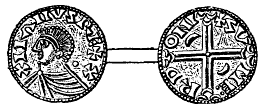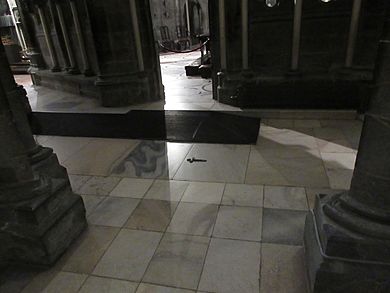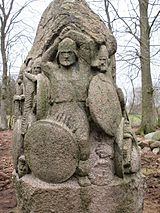Magnus the Good facts for kids
Quick facts for kids Magnus the Good |
|||||
|---|---|---|---|---|---|

Coin minted for Magnus the Good in Denmark
|
|||||
| King of Norway | |||||
| Reign | 1035 – 25 October 1047 | ||||
| Predecessor | Cnut | ||||
| Successor | Harald III | ||||
| Co-ruler | Harald III (1046–47) | ||||
| King of Denmark | |||||
| Reign | 8 June 1042 – 25 October 1047 | ||||
| Predecessor | Cnut III | ||||
| Successor | Sweyn II | ||||
| Born | c. 1024 Norway |
||||
| Died | 25 October 1047 (aged 23) Zealand, Denmark |
||||
| Burial | Nidaros Cathedral | ||||
| Issue | Ragnhild Magnusdatter | ||||
|
|||||
| House | St. Olaf (Vestfold branch of Fairhair dynasty) | ||||
| Father | Olaf II of Norway | ||||
| Mother | Alfhild | ||||
Magnus Olafsson (born around c. 1024 – died 25 October 1047) was a famous king. He is better known as Magnus the Good. He ruled Norway from 1035 and Denmark from 1042 until his death in 1047.
Magnus was the son of King Olaf II of Norway. When his father was removed from power in 1028, young Magnus and his mother had to leave Norway. He returned in 1035 and became king of Norway at just 11 years old. In 1042, he also became king of Denmark. Magnus ruled both countries until 1047, when he died. After his death, his kingdom was divided. Harald Hardrada became king of Norway, and Sweyn Estridsson became king of Denmark.
Contents
Magnus's Early Life and Journey
Magnus was the son of King Olaf Haraldsson. His mother was named Alfhild. When Magnus was born, he was very weak. People thought he might not survive.
Olaf was not there for his birth. His godfather, Sigvatr Þórðarson, named him Magnus. He chose this name after Karla Magnus, or Charlemagne, a great king. Against all odds, Magnus grew up strong and healthy. He became very important to his father, as he was Olaf's only son.
Leaving Norway
In 1028, the Danish king Cnut the Great took over Norway. King Olaf was removed from his throne. He went into exile with his family, including young Magnus. They traveled through mountains and forests in winter. They found shelter in Sweden for a while.
Later, they sailed across the Baltic Sea. They landed in Kievan Rus' (modern-day Ukraine and Russia). They stopped in Staraya Ladoga and then traveled to Novgorod. King Olaf asked Grand Prince Yaroslav the Wise for help. However, Yaroslav did not want to get involved in the fights in Scandinavia.
Life in Kievan Rus'
In 1030, Olaf learned that Cnut's ruler in Norway had disappeared. Olaf decided to return to Norway to try and regain his throne. He left Magnus to be raised by Yaroslav and his wife Ingegerd.
In 1031, Magnus learned that his father had died. This happened at the Battle of Stiklestad. For the next few years, Magnus learned Russian and some Greek. He also trained to be a warrior.
Returning to Norway
In 1035, the Norwegians were unhappy with Cnut's rulers. They wanted Magnus to return. Two important men, Einar Thambarskelfir and Kalf Arnesson, went to Kievan Rus'. They brought Magnus back to Norway.
Magnus's stepmother, Astrid, also strongly supported him. An army was gathered in Sweden. This army helped place Magnus on the Norwegian throne.
Becoming King of Norway and Denmark
Magnus was made king of Norway in 1035. He was only 11 years old. At first, he wanted to get revenge on those who had fought his father. But his godfather, Sigvatr, advised him to be fair. Magnus listened and stopped seeking revenge. This is why he became known as "the Good" or "the Noble".

Uniting the Kingdoms
Another son of Cnut, Harthacnut, was king of Denmark. He wanted Denmark and Norway to be one country again. Magnus started a military campaign against Denmark around 1040. However, important leaders from both countries brought the two kings together. They met at the Göta älv, which was the border between their kingdoms.
They made a peace agreement. They decided that whoever died first would be succeeded by the other. In 1042, Harthacnut died in England. This meant Magnus also became King of Denmark.
Challenges in Denmark
Even though Magnus was now king of Denmark, Cnut's nephew, Sweyn Estridsen, also claimed the throne. Sweyn had some support in Denmark.
To make his rule stronger, Magnus destroyed the Jomsborg. This was a famous Viking stronghold. Sweyn fled east but returned in 1043. He led an invasion by the Wends, a group of people from the south.
Magnus bravely defeated the Wends at the Battle of Lyrskov Heath. This battle was near Hedeby. In the battle, Magnus used his father Saint Olaf's battle-axe. It was called Hel. People said Magnus had dreamed of his father the night before. Norwegians believed they heard a special bell from Saint Olaf's church. This was a sign that Saint Olaf was watching over his son and the army. It was a huge victory, with many enemies defeated.
Sweyn continued to challenge Magnus in Denmark. But eventually, they reached an agreement. Sweyn became an Earl (a powerful leader) under Magnus in Denmark.
Plans for England
Magnus wanted to rule all the lands that Cnut the Great had once controlled. This included England. When King Harthacnut died, the English chose Edward the Confessor as their new king. Magnus wrote to Edward, saying he planned to attack England. He wanted to unite Norway and Denmark to take over England.
Most English people did not want Magnus as their king. Edward's mother, Emma, strangely seemed to favor Magnus. In 1043, King Edward took away her property. Some say she had promised to help Magnus.
Meanwhile, Magnus's uncle, Harald Hardrada, returned to Norway. Harald had been away in the east. He challenged Magnus's rule in Norway. Sweyn was still a threat in Denmark. Harald and Sweyn even became allies. To keep peace, Magnus decided to make Harald his co-king in Norway in 1046.
Magnus's Death

Sweyn kept putting pressure on Magnus from his base in Scania. But by late 1046, Magnus had forced Sweyn out of Denmark. However, on 25 October 1047, Magnus suddenly died in Denmark. He was either in Zealand or Jutland.
The exact cause of his death is not clear. Some stories say he fell overboard from a ship and drowned. Others say he fell off a horse. Another account says he became sick on a ship. It is said that before he died, he named Sweyn as his heir in Denmark and Harald as his heir in Norway. Magnus was buried with his father in Nidaros Cathedral in modern Trondheim.
What Magnus Looked Like
Historical writings describe Magnus as being of average height. He had regular features and a light complexion. He had light blond hair. People said he spoke well and made decisions quickly. He was known for being noble, very generous, a great warrior, and very brave.
Magnus's Family
King Olaf II's direct family line ended when Magnus died. However, in 1280, Eric II of Norway became king of Norway. He was related to Magnus through Magnus's sister, Wulfhild.
Magnus was not married. But he had a daughter named Ragnhild Magnusdatter. She married a Norwegian nobleman named Haakon Ivarsson. Ragnhild and Haakon had two daughters, Sunniva and Ragnhild. Sunniva's grandson later became King Eric III of Denmark. The other Ragnhild married Paul Thorfinnsson, an Earl of Orkney. Their son, Haakon Paulsson, also became an Earl of Orkney.
Images for kids
See also
 In Spanish: Magnus I de Noruega para niños
In Spanish: Magnus I de Noruega para niños






